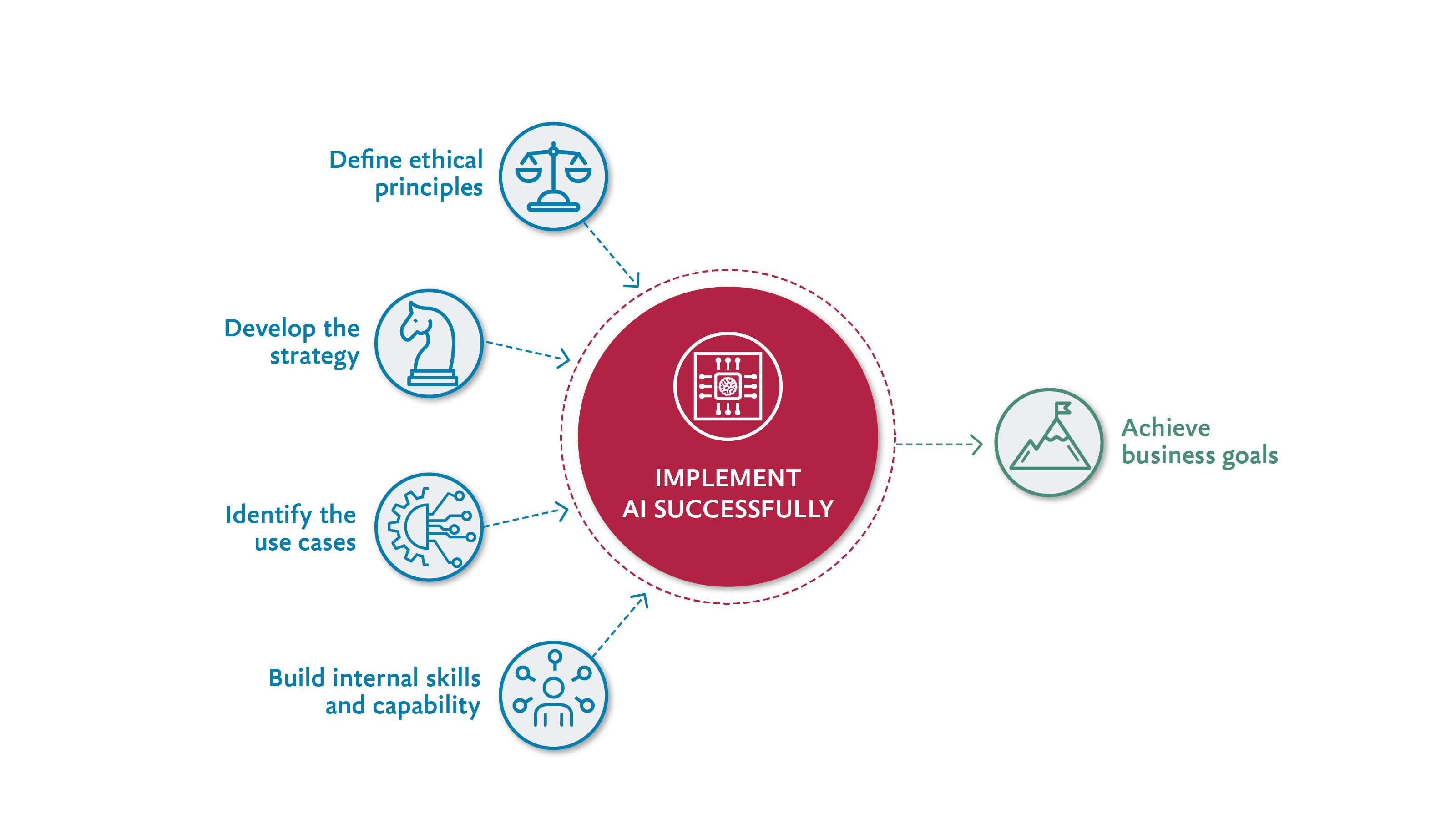How to adopt AI successfully
Artificial intelligence (AI) has become reality – a capability that businesses can now access like never before. This is unchartered territory for most leaders and they just don’t know where to start. How and where should their organizations implement AI?
Leaders need to focus on four key areas for success.

Define ethical principles for AI
AI will impact human activity and behaviour in unprecedented ways, creating a huge step change for society. The technology is sure to revolutionise the way we work, but it could also be highly disruptive to existing practices. We do not yet know the impact of AI on the workforce and machine learning could perpetuate unconscious bias or systemic injustice. These are just some of the contentious issues that have arisen over AI development, demonstrating the need for ethical implementation and sensitivity over how AI impacts people.
Some large organizations recognize they need to reassure people proactively. The likes of Google and Microsoft are openly publishing their ethical frameworks to show that their handling of AI is safe and principled, and to provide inspiration for other organizations.
AI ethics aren’t just for large businesses within the technology industry. Any organization that wants to apply AI technology will need to act responsibly – and demonstrate this to their staff, customers and other interested parties.
Before you move onto next steps, ensure you are clear on the ethical issues and put your own principles in place. This should be top of everyone's agenda.
Develop your AI strategy
To make AI work for your business, you need to think strategically. While AI may be completely new to your organization, the core strategic principles remain the same as for more familiar technologies. You should approach AI strategy development as you would any other business or technology strategy.
Critically, leaders need to bear in mind that adopting AI is not a strategy in and of itself. It is just a tool that can help organizations achieve their goals, and ultimately help the top and bottom line. Whether that means increasing productivity or growing market share, your AI strategy needs to start with your business objectives.
Ask the right questions:
- What is the business goal we are trying to achieve and how can AI help achieve it?
- Where and how can your organization use AI to increase productivity or reduce overheads?
- What current capabilities can AI augment or replace in order to drive up revenue?
- What timeframe for AI adoption is ambitious yet realistic in order to meet our strategic objectives?
- How do we build our own internal AI capability?
- Who should have access to AI tools?
Identify your AI use cases
Once you have a high-level idea of what AI could achieve for your organization, you need to think about specific business use cases. Examples include, but are not restricted to:
- Customer service operations, such as replacing call centres with chatbots
- Optimizing and automating processes
- Generating insights and predictions using advanced data and analytics
- Generating content for marketing and communications
- Supporting software engineers to develop code faster.
There are also functional use cases where AI can integrate with existing tooling. For example, off-the-shelf AI solutions can be added to some office software platforms to increase productivity and reduce time spent on menial tasks.
Specific objectives and circumstances will determine an organization’s priority use cases, but a helpful principle is to focus on the low-hanging fruit. Learn to crawl before you run. While this sounds obvious, starting with unrealistic ambitions is a common pitfall, and too often sets organizations up for failure.
By starting smaller, such as with making improvements to existing customer service chatbots, AI will feel less conceptual and overwhelming and become more tangible and usable in practice. It also begins to feel much more accessible for businesses that don’t have big AI or technology teams.
Build internal skills and capability in AI
Lastly, leaders need to consider the right level of internal skills and capability in AI, and how they can build it for the long-term. This can range from creating an AI centre of excellence as a new business function to raising basic AI literacy across the organisation.
The right approach will often mean a mix of upskilling, recruiting for new skills and expertise, and reducing over-reliance on third parties over time.
Successful AI adoption requires transformation best practice
The reality of AI will look different for each organization, and the full possibilities are still to be uncovered, but getting started on your journey shouldn’t feel impossible. As soon as you’ve determined your ethical framework, you need to stay focused on the strategic objectives, achievable use cases, and the right skills and capability.
Successful AI adoption is rooted in the same best practice principles as any other technology transformation. Getting this right will lay the best foundation for exploiting future AI technology developments so that you can achieve real business outcomes.











